#Horseshoe Crab Moon
Text
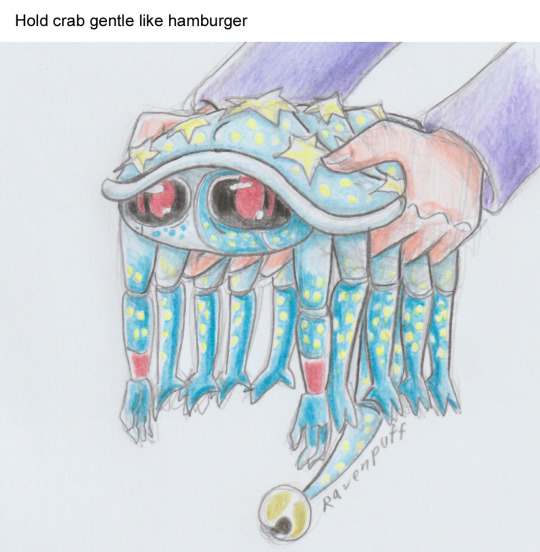
Happy MerMay, here's @thatmooncake's adorable Moonshoe Crab for the occasion! Follow this helpful diagram and even YOU can one day hold a celestial crab cutie, I'm sure.
Enjoy!
The Roan RPG Project
ScreeCon Server on Discord
Leave a Tip on Ko-Fi
#PuffBlog#MyArt#ThatMoonCake#DCA#Daycare Attendant#Moon Crab#Horseshoe Crab#Crab#Crab Moon#Horseshoe Crab Moon#Moon#MerMay#Merfolk#Mer#Daily Doodle#Sketch#Traditional Art#Colour
174 notes
·
View notes
Text
This one was rushed
[@thatmooncake ]

[big ol eyes]
Curiosity took over this creature and I learned this

#niko niko art#horseshoe crab#crab moon#horseshoe crab moon#fnaf moon#moondrop#dca moon#fnaf dca#the daycare attendant#dca community
94 notes
·
View notes
Text

I won't say I have art block. Just no desire to draw my own creations rn.
So here's @thatmooncake horseshoe crab moon

I want a plushy version so bad...
189 notes
·
View notes
Text



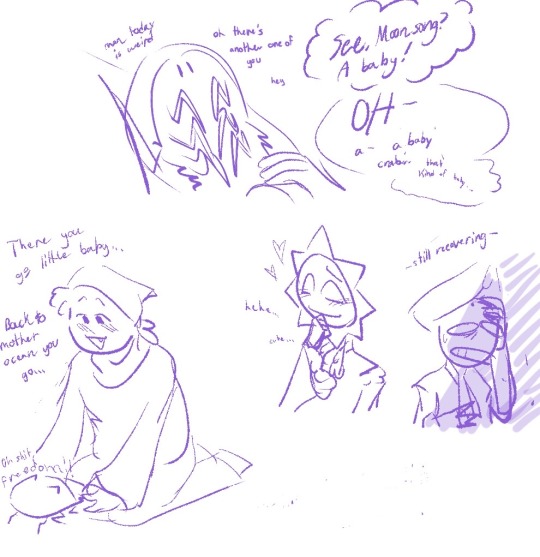
selkie reader and their sailor husbands have a lovely beach day,, 😌💕💕✨✨💕💕✨✨✨💕💕💕✨
(Could also be considered the “Omg this beach has free babies!!!” comic and/or “Moon thought he was a father for 0.2 seconds and damn near had a stroke about it” comic)
#horseshoe crab#crab#tw bug#tw bugs#does a horseshoe crab count as a big?? idk but just in case#selkie and sailors#selkie au#selkie reader#sailors sun and moon#fnaf au#fnaf sun x y/n#fnaf sun/moon x y/n#fnaf moon x y/n#fnaf sun x reader#fnaf moon x reader#silly bullshit#silly fluff#listen I just seriously love drawing the Stupidest expressions known to mankind on these characters ok#sketches#doodles#bones of a rabbit au#bones of a rabbit fnaf#sailor husbands
792 notes
·
View notes
Text
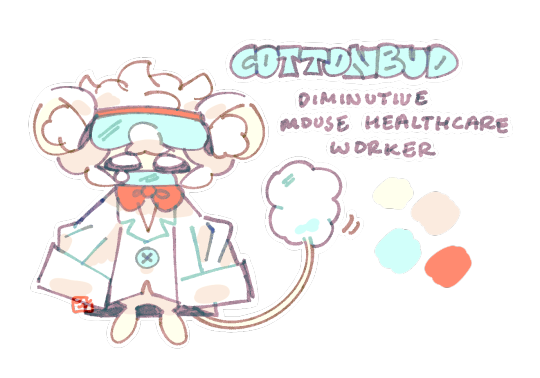
fuck it. plaguesona
#i thought of this a couple weeks ago on the bus a couple seats away from someone loudly coughing into the open air#i think something snapped and i decided to make a fuckin. medieval ass plague sona. horseman of pestilence fursona#this is also why i was asking abt animals with medical symbolism.. originally i wanted a two headed snake like the staff of caduceus#but it turns out thats actually hermes symbol. the real symbol for medicine is the rod of asclepius which looks pretty similar#the difference is that theres only one snake and its twined around a stick. ironically mercy from overwatch's weapons are named after#the caduceus despite the misconception LMAOOO#snakes were the most consistent medicine related animal i could find even across multiple cultures so it couldve really worked#if i could actually draw scalies.. one of my earliest sketches had a cobra with a syringe at the end of its tail like a rattlesnake#and it had markings similar to the syringe tube but i didnt have much else going on so i scrapped it#i was also recommended animals with less obvious ties to medicine like jellyfish and horseshoe crabs and learned something new ^_^#im not confident i could pull off a non-mammal furry but they were really good ideas i might put into smth else.. i also thought of#axolotls bc of their regenerative thing and growing back limbs but i think that would suit smth like a surgeon or amputation...#possums and bats were also an option bc theyre actually really resistant to most diseases like rabies but i feel like ppl wouldnt know that#if they saw it so it looks a little ironic at a glance. rabbits rats and mice were my second option bc of animal testing and lab rats#less obvious reference but the moon rabbit in chinese mythology is loosely connected to medicine bc it makes the elixir of life#otherwise lab mice in a pharmacy / modern medicine setting seemed fitting and jerboa tails remind me of cotton buds#and. ironically. jerboas are more closely related to elephants than rats and mice. can you believe it#my art#myart#my oc#sona#plaguesona#cottonbud#fur#furry art#character design#ref sheet#oc ref sheet
130 notes
·
View notes
Text

These little guys will be available as stickers in my upcoming project, Spineless Wonders!
Check out the Kickstarter here!
#illustration#digital art#polls#kickstarter#animals#invertebrate#octopus#jellyfish#moth#snail#horseshoe crab#stickers#blue ringed octopus#pink moon jelly#luna moth#cuban painted snail
29 notes
·
View notes
Text
My tattoo artist yesterday told me that I was really good at getting tattooed and all I could think about was that I was getting a good grade in tattoo
#anyway now i got a funny guy#id post a pic but its on my thigh and i feel uncomfortable posting the pic i have of it freshly done here#where strangers can see#its on the middle-lower outer thigh and takes up a sizable chunk so you have an idea where it is#maybe if i can get a pic that is mainly tattoo ill post it#but for now just imagine a funny skeleton in a medieval bard outfit playing a lute sitting on the moon#the moons got a face kinda like an old picture book or smth#so ive been calling them funny guy and mr moon#funny guy needs a better name but also i dont usually name things tbh#my horseshoe crab tattoo doesnt have a name and i got that last august#oh well#its a non-issue#enjoy my midnight ramblings
2 notes
·
View notes
Text
Often, moonlight—independent of the tides—signals the start of a species-wide reproductive marathon. By syncing these orgies to particular phases of the moon—one of nature’s most prominent and reliable records of time—animals increase their chances of finding a mate and overwhelm opportunistic predators with their sheer numbers.
During certain phases of the moon, Sesarma crabs in Japan collectively scuttle across mountain slopes toward sea-flowing rivers, where they release their eggs and sperm. The annual migrations of Christmas Island crabs, which move in waves of crimson from forest to sea to mate and lay their eggs, also seems to be linked to moonlight’s shifting intensity. Moonlight even sharpens the visual acuity of horseshoe crabs, which come ashore on certain nights to mate. Likewise, studies suggest that the moon’s glow is one of the environmental triggers for synchronous spawning in tropical rabbit fish. Moonlight likely increases production of the hormone gonadotropin in these fish, which promotes gamete maturation.
— The Lunar Sea
#ferris jabr#the lunar sea#science#biology#marine biology#animals#animal behaviour#genetics#astronomy#oceanology#japan#christmas island#crabs#sesarma reticulatum#christmas island red crabs#horseshoe crabs#rabbitfish#reproduction#tides#moon#light#gonadotropins
2 notes
·
View notes
Text

0 notes
Text
Moon but he’s a horseshoe crab:
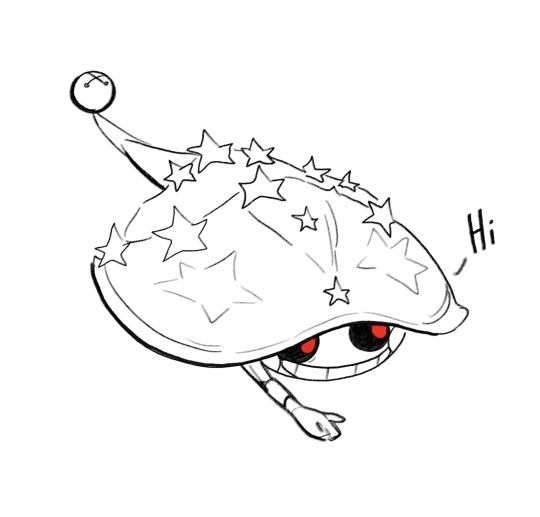
2K notes
·
View notes
Text






Todays magma doodles from @daycarefriendpickup's session! Ft. @thatmooncake 's horseshoe crab Moon <3
#fnaf#fnaf security breach#fnaf help wanted 2#five nights at freddy's security breach#five nights at freddy's help wanted 2#fnaf daycare attendant#fnaf jack o moon#fnaf moon#fnaf moondrop#magma#bloo's art
354 notes
·
View notes
Text
i know So Much about horseshoe crabs now you guys. did you know in malaysia they're called belangkas and their family is limulidae and they have these weird little pusher feet on the back to scoot around and they've been around for at least 450 million years and their blood is cerulean because it has hemocyanin and copper and also has these things called amebocytes that glorb around viruses and pathogens + because of that their blood is used to test if medical drugs are sterile (if you've ever gotten a medical injection, it was probably tested on horseshoe crab blood first!) and also that they are really really tiny when they're born and molt A Lot (literally just crawl out of their skeletons + expand. so cool) and the females are much larger when full grown than the males and also have flat fronts of their shells as opposed to the curved arches the males have for mating and it takes them ten years to reach sexual maturity and they're actually NOT CRABS they're more closely related to arachnids and they have an open circulatory system and they're nocturnal and come out to mate with the full moon but other than that people don't really know where they live most of their lives and and and



HORSESHOE CRABS!!!
177 notes
·
View notes
Text

SWORDTEMBER DAY 14 : ROYAL GUARD
Crown’s Carapace, of steadfast steel and faithful blood 🦀🛡️
“‘So then, ‘Little Nymph’’ said the guard, and the prince rolled their eyes, ‘You better stay within my eyesight.’ The prince looked to her. She was tall, and bulky plates of chitin grew from her body into a beautiful suit of living armour. At her hip, her family’s sword hung. The blade was a solid piece of metal, and, like her, was designed to defend. The Ferrequin family had been royal guards to the lineage of The Queen for generations, and now the young prince had been assigned their own escort.
‘I’ll stay close. But you keep me safe, okay?’
‘Of course, my prince.’ She made a swooping bow, far too over the top, and looked to the prince with a wry smile.
‘Ferrequin?’
‘Yes?’
‘You’re an idiot.’ Their guard laughed, and a rare smile graced the prince’s lips. The two of them looked out from their balcony, over the bustling roads and swarming markets of the kingdom. There, under the pale moon, the world felt very big for two bugs. "
Another bug blade, linked to yesterdays :D (and yes before anyone says I do know that horseshoe crab blood is blue ehehe)
Yesterday’s sword!
You can support me on Patreon for £1 and help me make stuff like this!
#curated curios#swordtember2023#swordtember#art#artwork#animated#animation#animators on tumblr#illustration#illustrators on tumblr#artists on tumblr#dnd item#dnd homebrew#dnd#5e homebrew#homebrew#dnd 5e homebrew#item#magic item#pretty#digital art#digital#dungeons and dragons#fantasy#fantasy art#fantasy writing#writing#writing tumblr
478 notes
·
View notes
Text
Y’all remember that one bunch of silly low effort doodles I did of selkie reader finding a horseshoe crab on th beach,, well now there’s ✨more✨ (starring Moon)
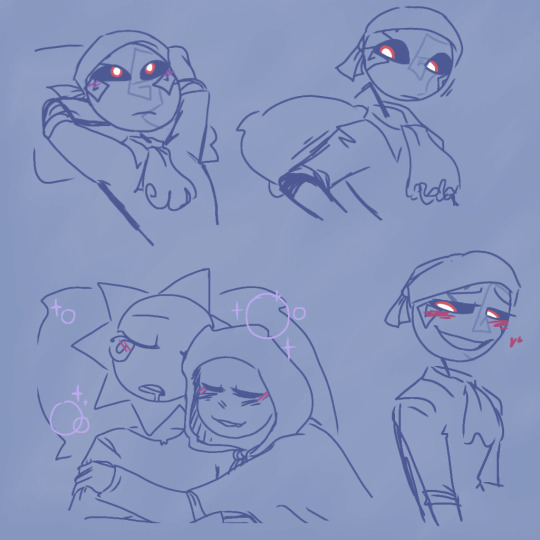
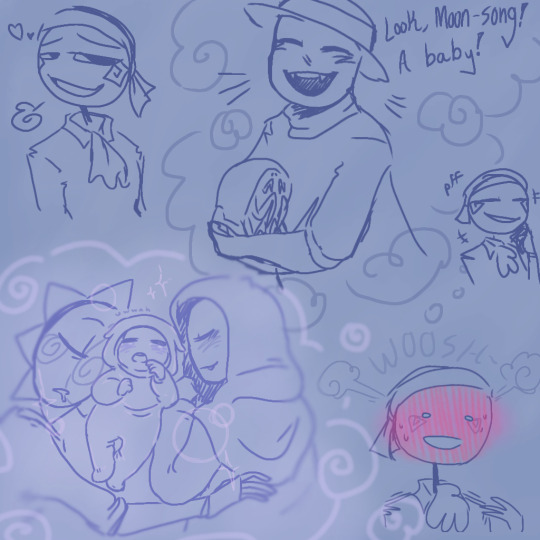
(pt one and two,, :3c)
(Next part here!)
#doodles#sketches#silly fluff#silly bullshit#fnaf au#selkie reader#selkie and sailors#selkie au#sailors sun and moon#fnaf sun/moon x y/n#fnaf sun/moon x reader#fnaf moon x y/n#fnaf moon x reader#sleepy cuddles#cuddles and snuggles#free baby saga#bones of a rabbit au#short comic#moon out here having multiple crisises at once lmaooooo#baby: exists. sun/moon: Dad Mode Activated
979 notes
·
View notes
Photo

inspired by this ask
horseshoe crab Moon by @thatmooncake
(masterpost)
#fnaf sb#fnaf daycare attendant#fnaf moon#fnaf moondrop#mermay#i had to i just HAD TO#wanted to draw him in the beach... but the dots drained my energy ywy#so now you have a tiny moonshoe crab handed to you#take this#kazzy dibuja
880 notes
·
View notes
Text
Happy New Year!
Let's imagine it was the Earth itself that was going into its 2024th year. That is to say, we're compressing the entire history of the Earth into just the past 2023 years. What events would have happened when?
Well, not too much is certain about the first couple decades after our planet formed, until around 50 CE when we were hit by another proto-planet, Theia, and the debris formed the Moon. After a couple years of the planet cooling down again, the oceans formed out of boiling rain. The timing of the origin of life is very uncertain, but there are chemical signs it may very well have happened as early as the second century. Around 200 CE, the gas giants did a big funky orbit-swapping dance, and in the process inflicted the Late Heavy Bombardment on the rest of the solar system, meaning the Earth was suffering a ton of meteorite strikes for the entire third century.
The first indisputable evidence of life is from around 330, and the first stromatolites appear around 470. Those are basically the first fossils, stones created by layer upon layer of oxygen-producing cyanobacteria living and dying on top of one another. But even with oxygen producers evolving, it would take many centuries before oxygen became a major part of the atmosphere: not until the Great Oxygenation Event, which happened during the ninth and tenth centuries. That's also about the time the first complex, eukaryotic cells evolved through a symbiosis between an anaerobic archaean and an oxygen-breathing bacterium. The bacterium became more and more focused on just the oxygen-breathing task inside the larger cell, until its descendants were mitochondria, which as you all know are the powerhouse of the cell. The next seven centuries passed by with only slow, gradual changes, and life continuing to be unicellular and difficult to find in the fossil record.

(1735's Snowball Earth, by me)
From 1704 to 1730, the entire planet froze over. After merely two years of thaw, it happened again, this time lasting from 1732 to 1742. But these snowball Earth episodes set the stage for the evolution of animals that began right after. Across the mid-18th century, the bizarre Ediacaran biota, with its strange symmetries, fronds, and fractal-like pattern filled the oceans. In the early 1780s they went extinct, possibly due to a temporary drop in oxygen-levels, only to be replaced by a great variety of quite different creatures in the Cambrian Explosion.
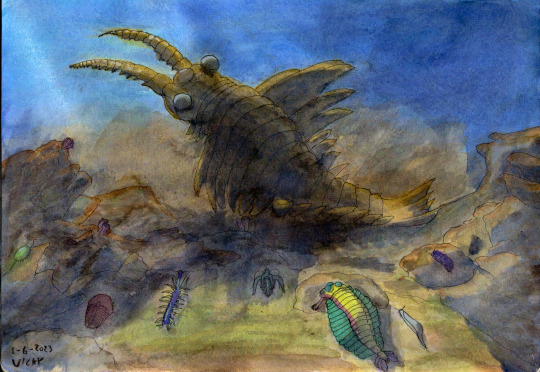
(Class of 1799, by me)
Starting in 1784 and running for a few decades, the Cambrian period saw the origin of most of the modern animal phyla, reaching its most famous form in the Burgess Shale fauna of 1799. During this time, most animals still lived on the sea floor, either attached or crawling, with relatively few actually swimming creatures. Plants started tentatively moving onto land around 1817, and in 1825, the rising of the great Appalachian mountains caused a severe drop in global CO2 and thus temperatures, leading to the Late Ordovician mass extinction.

(Horseshoe crabs and sea scorpions on a beach in 1834, by me)
Bony fish first showed up during the 1830s, and around the same time plants were getting serious about inhabiting the land, evolving roots and vascular tissues so they could properly grow there. Millipedes and the ancestors of spiders were the first animals to follow them onto land. Our own fishy ancestors did not take their first step until 1857, by which point the arthropods were well established there and the plants had figured out how to become trees. The Late Devonian extinction, partially caused by the evolution of said trees and partially by the south pole freezing, played out in two pulses over the late 1850s and early 1860s.
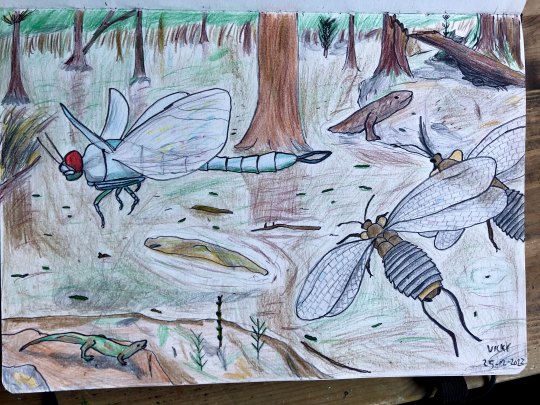
(Swamp prominently featuring Meganeura and Mazothairos in 1889, by me)
Arthropods and vertebrates continued to gain adaptations to life on land. The insects became the first creatures ever to fly in 1878, and the high-oxygen atmosphere of the time would be especially good to them. Around 1884, a group of vertebrates called the amniotes, after the membrane that kept water inside their eggs so they could lay them on land without them drying out, split into two groups: the reptiles and the synapsids (which we mammals descend from). The next few decades would see the synapsids in particular being extremely successful as the supercontinent Pangaea formed. Until 1912, when a massive episode of volcanism caused the worst mass extinction of all time, the Great Dying, scouring the Earth of a huge portion of its life.
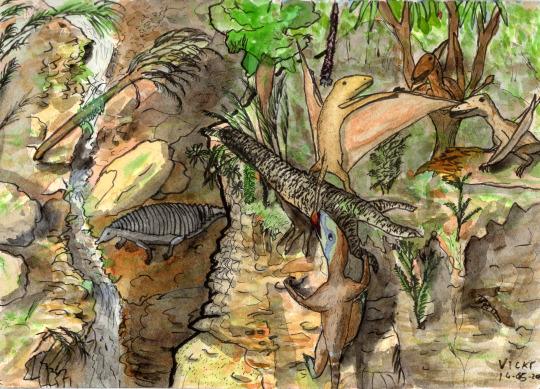
(A 1930 scene featuring the three branches of archosaur: dinosaur, pterosaur, and pseudosuchian, by me)
The 1910s were a period of slow recovery during which strange new forms of animal evolved. Many different, unrelated reptiles, such as the ichtyosaurs and plesiosaurs, went to sea, where they would continue to provide some of the most impressive creatures for most of the 20th century. On land, the dinosaurs first appeared in 1920, though for the next decade or so they'd live in the shadow of their pseudosuchian (crocodile-line) cousins. In 1934, Pangaea began to break up, resulting in another terrible pulse of volcanism that caused a lot of extinctions and left particularly the feathered and furry survivors with a lot of empty niches to fill, allowing the dinosaurs and mammals to diversify greatly. The last common ancestor of all modern mammals lived in the early 1940s, and by 1957 the dinosaurs had figured out flight, with Archaeopteryx usually being considered the first bird. Other dinosaurs took on an incredible variety of sizes, shapes, and forms. Some of the most famous ones include Dilophosaurus (1942), Diplodocus and Stegosaurus (1955), Iguanodon (1969), Velociraptor (1991), and Tyrannosaurus rex (1994).

(A tropical lakeside in the year 2000, by me)
In 1995, the world was struck by a meteorite, wiping out many groups, including the marine reptiles, pterosaurs, and ammonites. The surviving mammals and dinosaurs went on to diversify across the next couple of years and had formed thriving new ecosystems in the tropical world of the turn of the millennium. The first known bat lived in 2001, and the whales returned to the oceans next year. Around 2009, the world's climates turned colder and dryer. Antarctica froze over and grasslands spread widely. Our last common ancestor with the chimpanzees and bonobos lived in 2021, and by new year 2023, our ancestors were getting brainier and more proficient with tools. That's also when the north pole froze and the Quaternary ice age cycle began. The first known members of Homo sapiens lived on 10 November 2023. The latest ice age started on 14 December, and ended at 2 AM on 30 December. The great pyramid of Giza was built at 6 AM on 31 December and On The Origin Of Species was published at 23:22 PM.
#palaeoblr#happy new year#2024#geologic timescale#vicky's vritings#one year is 2.244 million years if you're curious#and yes i did exclude both year 0 and 2024#since 0 doesn't exist and 2024 hasn't happened yet#my art#i rather enjoy having an extensive collection of my art to illustrate my paleorambles nowadays#incidentally the big bang occurred in 4121 bce at this scale#which is curiously close to the date of creation creationists made up#if only they would follow through and insist humanity itself was seven weeks old too
124 notes
·
View notes